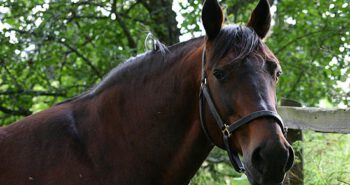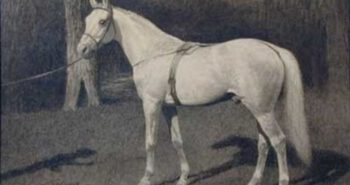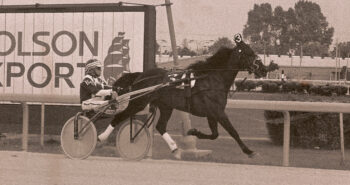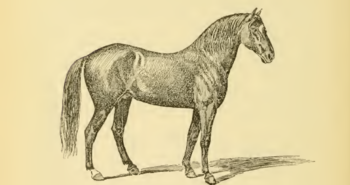He was one of the thousands of Orlov trotters exported from Russia in the golden age of the breed. Kozyr found a new home in France, was one of the best aged trotters in France for several years and is today found in every French pedigree.
From the mid-1860s to the mid-1880s, the Russian Orlov trotter reigned supreme in trotting Europe, which admittedly was in its infancy. The first Orlov trotters were exported from Russia to Italy and Austria in the 1840s. The demand for the breed really took off after the World’s Fair in Paris in 1867, when the Orlov trotter Bedouin made headlines by trotting 3500 feet (1066 meters) in 1:32. Converted to a full mile of 5280 feet this gives a mile rate of 2:18.4 (1.26,3) while Flora Temple’s world record for the mile then stood at 2:19 3/4 (it would later that year be lowered by Dexter to 2:17 1/4). After the performance demand for Orlov trotters increased substantially and for some years up to 10 percent of the annual Orlov crops were for exported from Russia. At the next World Fair in the French capital, in 1878, grey stallion Lyubezny won the grand prize by trotting 6000 meters (roughly 3 3/4 mile) in 1.40,2 (2:41.1).
Several Orlov trotters excelled in France in this period, but none of them shone at stud. The only one who left any kind of lasting legacy was the graceful black stallion Kozyr. Born in Russia in 1877, Kozyr started to make a name for himself by winning three races at the legendary Moscow Hippodrome in 1884. He was not dominant at first, however, and after winning in his debut he failed to place in several races. The following year he established himself as one of the best in the country by defeating the rest of the Russian elite in the Grand Prix of Moscow, winning in 1.35 (2:32.4) over 4800 meters (nearly 3 miles), thus beating the famous Orlov trotter Polkan’s record time over the distance.
Joining the French elite
The colt was purchased by H Everts of France in mid-1885 before being resold, though it’s not been possible to ascertain exact date of purchase or price. Translating names from Cyrillic is not always straightforward, and Kozyr was no exception. Starting out as “Korzyr” in his new homeland, he was then referred to as both “Kozir” and “Kozyr” before the latter was exclusively used from mid-1886. The first mention of him in France is in La France Chevaline as “Korsyr” winning the Poule International de Paris at Vincennes on Oct 12, 1885, covering the 5500 meters (3 7/16 mile) in 1.47,9 (3:09.4), winning by quite a margin to second-placed Kremene.
That following year Kozyr firmly established himself as one of the top aged trotters in France by winning the Grand International at Vincennes, the Prix de la Ville at Rouen as well as second-places in the Prix de Villleurbane at Lyon and Grand International de Trouville at Deauville. In the Prix de Vincennes in April that year he finished first ahead of Capucine, but was disqualified after breaking several times during the race.
At the beginning of January 1887 Kozyr won the marathon race Prix du Bois in 10:22,2 over 6000 meters (roughly 3 3/4 mile), a kilometer time of 1.43,7 (2:46.4). He followed up in the Prix de Vincennes three months later, defeating the best French horse that the time, the mare Capucine. He set his record in the Prix de la Cite in Rouen, trotting the 4800 meter (roughly 3 miles) monte race in 7:41, a kilometer time of 1:36 (2:34 1/2), which was also a world record. Two weeks later, on Jul 10, 1887, he suffered a rare loss when he finished third in Prix Rivoli at Vincennes, but the following day he won the Prix International de Juillet as the overwhelming favorite. The Russian-born trotter was irresistable that summer as he then easily won Prix de Pont-l’Eveque at Vincennes in August. At 10, Kozyr was at the pinnacle of his career, and Le Revue des sports perfectly summed up how the black colt was viewed: “the eternal Kozyr, this horse that has been running since the flood, and refuses to quit until the last decision.”
It wasn’t just his abilities on the track that was impressive: the coal black Kozyr, measuring 157 cms (15,2 hands) at the withers, was clearly a looker. As Albert Viel wrote in an article in Le Sport Universel Illustre in Januar 1924, “Look at pretty little Kozyr and tell me if you’ve ever seen a horse with a more intelligent physique. He is the grandfather of Virois, who gave Mr Ceran-Maillard a host of high quality trotters and in particular Reynolds V who is strangely reminiscent of his oriental great-grandfather.”
Opposition from breeders
On Jan 2, 1888, Kozyr won the Prix de l’Ete at Vincennes, covering 5000 meters (3,1 miles) in 8:04,8, a kilometer time of 1.37 and a mile time of 2:36. At 11, Kozyr was not unbeatable, though, and on Jul 9, 1888, he narrowly lost the Prix de Saint-Mande to American import Misty Morning, driven by her owner AE Terry. Kozyr still won several races at 11, but after he fell lame in the 1888 Poule International de Paris, on Oct 8, the decision was made to retire him to stud. The national stud stood ready with open arms and bought the stallion for 22.000 francs, a sizeable sum at the time.
Not everybody was convinced, though. In this book Le cheval normand et ses origins, published shortly after Kozyr was purchased in 1889, author Edmond Gast served up something amounting to a character assassination of the future stallion: “Before closing this chapter, I would like like to ask the Stud Administration one question: The results produced, in the past, by the presence of the Russian stallion, Marx, in the Forcinal stable, was not enough to teach buyers and breeders about the disastrous influence that this blood has produced on our Norman breed, so that we have recently purchased the Kozyr stallion, and this for 22,000 francs, a price that no Norman breeder has never been able to obtain? Here again, the instruction of a minister alone could, we are convinced, force the Administration to send into storage this famous trotter, who has none of what is needed to make a sire. Let the breeders of La Manche not be seduced by its speed. That it is useless is ignored! But it’s not necessary to do so!”
Leaving a legacy
The appeal fell on deaf ears and Kozyr stood stud at the Haras de Saint-Lô from 1889 until he died prematurely at April 14, 1893. His stud career did not resemble his massively successful raceing career, though he would leave a lasting legacy. Though the exact number of foals is lost to history, Kozyr only produced nine trotters who trotted faster than a 2.00 kilometer time. One of these was his grey daughter Odessa born in 1892. Described as a mare with a remarkable burst of speed but “completely lacking in poise”, Odessa’s on-track performances were modest. As a broodmare, however, she more than made up for that. She gave birth to Virois, by Harley, in 1899, a colt that was bought by Herve Ceran-Maillard.
Virois became the Frenchman’s favorite horse, so much so that he would add “V” to the name of all trotters he bred for many years. Virois was a good stallion who produced quite a few good trotters, the best one being Reynolds V winner of the 1922 Prix d’Amerique. Odessa’s daughter Hermione V produced the excellent Telemaque V, one of the best French trotters in the late 1920s. Telemaque V and Virois are found several times in the maternal pedigree of Ready Cash. Through Nicias Grandchamp, Telemaque V also occurs in the pedigree of Indy de Vive, and Kozyr thus is found five times in the pedigree of Ready Cash.
KOZYR
Black colt born in Russia in 1877. Died at Saint-Lô, France on Apr 14, 1893.
Varvar – Koketka (unknown sire)
1.36 over 4800 meters (2:32.4MR roughly three miles)
Breeder: Borisovsky stud farm
Owners: Borisovsky stud farm – H Everts – French national stud
Trainers: –
Drivers: Malcom and others
Grooms: –





